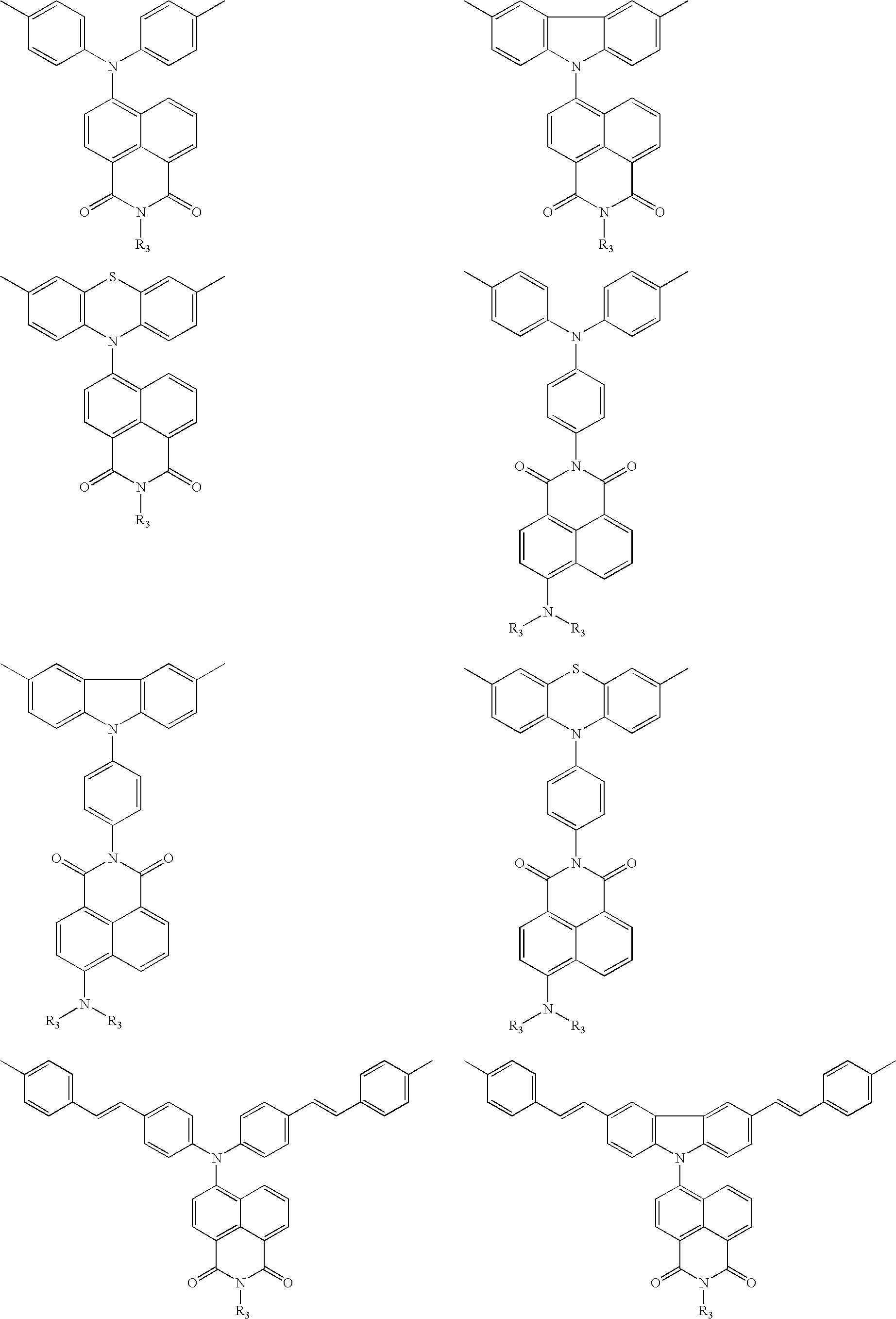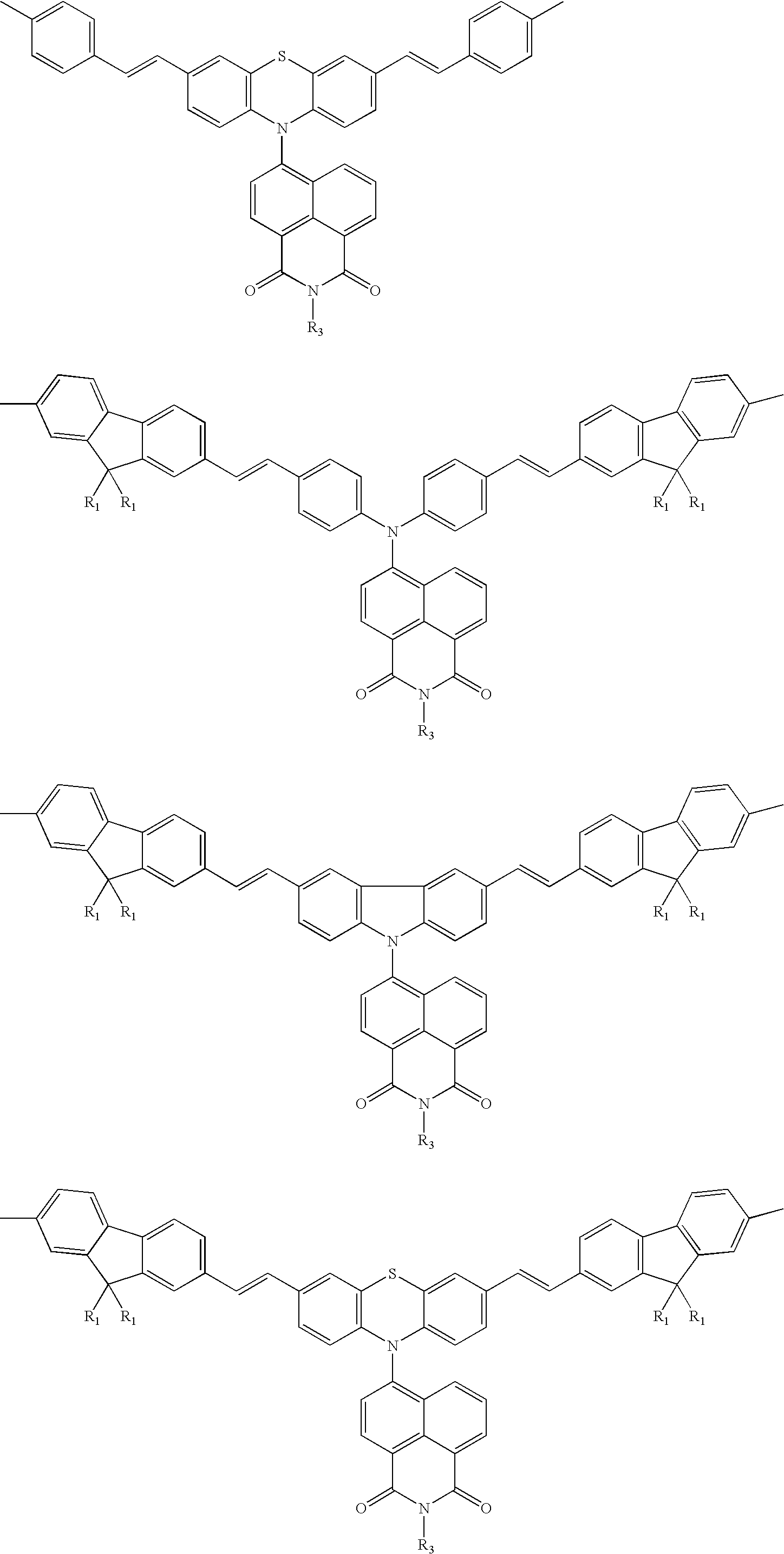White electroluminescent polymeric material & preparation thereof
a polymeric material and electroluminescent technology, applied in the field of preparation thereof, can solve the problems of difficult to obtain stable white light device, poor performance sharp voltage-dependent color of white light polymeric device, etc., and achieve stable white electroluminescent polymeric material system and high efficiency
- Summary
- Abstract
- Description
- Claims
- Application Information
AI Technical Summary
Benefits of technology
Problems solved by technology
Method used
Image
Examples
example 1
Synthesizing of 4-bromo-9-(4-t-butylphenyl)-1,8-naphthalimide
[0122] Under the protection of N2 gas, 4-bromo-1,8-naphthalic anhydride (10.0 g, 36.2 mmol), p-t-butyl aniline (6.0 g, 40.1 mmol) were added into a reacting flask containing 120 ml of acetic acid as a solvent. After reacting while magnetic stirring at 130° C. for 10 hr, the reaction product was poured into water, filtered, washed repeatedly, and separated by column chromatography. 8.10 g (yield 55%) of a white solid 4-bromo-9-(4-t-butylphenyl)-1,8-naphthalimide was obtained. 1H NMR (CDCl3, 300 MHz) δ 8.68(d, 1H), 8.59(d, 1H), 8.43(d, 1H), 8.04(d, 1H),7.86 (t, 1H), 7.56 (d, 2H), 7.23 (d, 2H), 1.38 (s, 9H).
example 2
Synthesizing of 4-N,N-diphenyl-9-(4-t-butylphenyl)-1,8-naphthalimide
[0123] Under the protection of N2 gas, 3 ml of DMPU solvent was added into a mixture of 4-bromo-9-(4-t-butylphenyl)-1,8-naphthalimide (4.48 g, 11.0 mmol), diphenylamine (1.69 g, 10.0 mmol), anhydrous potassium carbonate (1.53 g, 11.0 mmol), cuprous iodide (0.096 g, 0.50 mmol), and 18-crown-6 (0.13 g, 0.50 mmol). After reacting while magnetic stirring at 190° C. for 20 hr, the reaction product was extracted with dichloromethane, acid washed, ammonia liquor washed, water washed repeatedly, and separated by column chromatography. 1.74 g (yield 35%) of an orange red solid 4-N,N-phenyl-9-(4-t-butylphenyl)-1,8-naphthalimide was obtained.
[0124]1H NMR (CDCl3, 300 MHz) δ 8.61(d, 1H), 8.54(d, 1H), 8.22(d, 1H), 7.57-7.50 (m, 3H), 7.40 (d, 1H).7.30-7.22(d, 6H),7.11-7.04 (m, 6H), 1.38 (s, 9H).
example 3
Synthesizing of 4-N,N-di(4-bromophenyl)-9-(4-t-butylphenyl)-1,8-naphthalimide
[0125] 4-N,N-diphenyl-9-(4-t-butylphenyl)-1,8-naphthalimide (1.49 g, 3.0 mmol), tetra-n-butylammonium tribromide (3.16 g, 6.6 mmol) were dissolved in 50 ml of dichloromethane. After reacting at room temperature for 10 min, the reaction product was poured into water. The organic layer, after washing repeatedly, was separated by column chromatography. 1.91 g (yield 97%) of an orange red solid (pure intermediate product)-4-N,N-di(4-bromophenyl)-9-(4-t-butylphenyl)-1,8-naphthalimide was obtained. 1H NMR (CDCl3, 300 MHz) δ 8.60(d, 1H), 8.55(t, 1H), 8.16(d, 1H), 7.60(d, 1H), 7.56(d, 2H), 7.42-7.37 (m, 5H).7.22(d,2H), 6.90(d,4H), 1.38 (s, 9H).
PUM
| Property | Measurement | Unit |
|---|---|---|
| Temperature | aaaaa | aaaaa |
| Temperature | aaaaa | aaaaa |
| Temperature | aaaaa | aaaaa |
Abstract
Description
Claims
Application Information
 Login to View More
Login to View More - R&D
- Intellectual Property
- Life Sciences
- Materials
- Tech Scout
- Unparalleled Data Quality
- Higher Quality Content
- 60% Fewer Hallucinations
Browse by: Latest US Patents, China's latest patents, Technical Efficacy Thesaurus, Application Domain, Technology Topic, Popular Technical Reports.
© 2025 PatSnap. All rights reserved.Legal|Privacy policy|Modern Slavery Act Transparency Statement|Sitemap|About US| Contact US: help@patsnap.com



